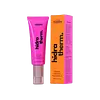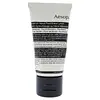What's inside
What's inside
 Key Ingredients
Key Ingredients

No key ingredients
 Benefits
Benefits

 Concerns
Concerns

 Ingredients Side-by-side
Ingredients Side-by-side

Water
Skin ConditioningCoco-Caprylate/Caprate
EmollientGlycerin
HumectantCocos Nucifera Oil
MaskingCetearyl Olivate
Lauryl Olivate
Sorbitan Olivate
EmulsifyingCetearyl Alcohol
EmollientPhenoxyethanol
PreservativeTocopherol
AntioxidantAllantoin
Skin ConditioningParfum
MaskingMacadamia Ternifolia Seed Oil
EmollientHydrolyzed Caesalpinia Spinosa Gum
AbsorbentEthylhexylglycerin
Skin ConditioningCaesalpinia Spinosa Gum
Skin ConditioningGardenia Taitensis Flower Extract
Skin ConditioningSodium Benzoate
MaskingPotassium Sorbate
PreservativeWater, Coco-Caprylate/Caprate, Glycerin, Cocos Nucifera Oil, Cetearyl Olivate, Lauryl Olivate, Sorbitan Olivate, Cetearyl Alcohol, Phenoxyethanol, Tocopherol, Allantoin, Parfum, Macadamia Ternifolia Seed Oil, Hydrolyzed Caesalpinia Spinosa Gum, Ethylhexylglycerin, Caesalpinia Spinosa Gum, Gardenia Taitensis Flower Extract, Sodium Benzoate, Potassium Sorbate
Water
Skin ConditioningRosa Canina Fruit Oil
EmollientGlycerin
HumectantCetearyl Olivate
Cetearyl Alcohol
EmollientStearic Acid
CleansingHamamelis Virginiana Water
AstringentSorbitan Olivate
EmulsifyingButyrospermum Parkii Butter
Skin ConditioningPolysorbate 20
EmulsifyingPhenoxyethanol
PreservativeOlea Europaea Fruit Oil
MaskingFusanus Spicatus Wood Oil
MaskingBisabolol
MaskingPanthenol
Skin ConditioningSodium Benzoate
MaskingDisodium EDTA
Sodium Citrate
BufferingPogostemon Cablin Leaf Oil
MaskingCitrus Aurantium Dulcis Flower Oil
AstringentEugenia Caryophyllus Flower Oil
MaskingZingiber Officinale Root Extract
MaskingBenzoic Acid
MaskingFarnesol
PerfumingEugenol
PerfumingLinalool
PerfumingLimonene
PerfumingGeraniol
PerfumingWater, Rosa Canina Fruit Oil, Glycerin, Cetearyl Olivate, Cetearyl Alcohol, Stearic Acid, Hamamelis Virginiana Water, Sorbitan Olivate, Butyrospermum Parkii Butter, Polysorbate 20, Phenoxyethanol, Olea Europaea Fruit Oil, Fusanus Spicatus Wood Oil, Bisabolol, Panthenol, Sodium Benzoate, Disodium EDTA, Sodium Citrate, Pogostemon Cablin Leaf Oil, Citrus Aurantium Dulcis Flower Oil, Eugenia Caryophyllus Flower Oil, Zingiber Officinale Root Extract, Benzoic Acid, Farnesol, Eugenol, Linalool, Limonene, Geraniol
Ingredients Explained
These ingredients are found in both products.
Ingredients higher up in an ingredient list are typically present in a larger amount.
Cetearyl alcohol is a mixture of two fatty alcohols: cetyl alcohol and stearyl alcohol. It is mainly used as an emulsifier. Emulsifiers help prevent the separation of oils and products. Due to its composition, it can also be used to thicken a product or help create foam.
Cetearyl alcohol is an emollient. Emollients help soothe and hydrate the skin by trapping moisture.
Studies show Cetearyl alcohol is non-toxic and non-irritating. The FDA allows products labeled "alcohol-free" to have fatty alcohols.
This ingredient is usually derived from plant oils such as palm, vegetable, or coconut oils. There is debate on whether this ingredient will cause acne.
Due to the fatty acid base, this ingredient may not be Malassezia folliculitis safe.
Learn more about Cetearyl AlcoholCetearyl Olivate is an emulsifier and texture enhancer. It is derived from the fatty acids of olive oil and Cetearyl alcohol, and is biodegradable.
As an emulsifier, it is used to prevent oils and waters from separating. It can also
Manufacturers use the name Olivem 1000. This ingredient has been found to preserve the natural microbiome of skin. Having a healthy microbiome helps keep our skin healthy and protects against harmful bacteria. This ingredient is grouped with Sorbitan Olivate under the name Olivem 1000.
Learn more about Cetearyl OlivateGlycerin is already naturally found in your skin. It helps moisturize and protect your skin.
A study from 2016 found glycerin to be more effective as a humectant than AHAs and hyaluronic acid.
As a humectant, it helps the skin stay hydrated by pulling moisture to your skin. The low molecular weight of glycerin allows it to pull moisture into the deeper layers of your skin.
Hydrated skin improves your skin barrier; Your skin barrier helps protect against irritants and bacteria.
Glycerin has also been found to have antimicrobial and antiviral properties. Due to these properties, glycerin is often used in wound and burn treatments.
In cosmetics, glycerin is usually derived from plants such as soybean or palm. However, it can also be sourced from animals, such as tallow or animal fat.
This ingredient is organic, colorless, odorless, and non-toxic.
Glycerin is the name for this ingredient in American English. British English uses Glycerol/Glycerine.
Learn more about GlycerinPhenoxyethanol is a preservative that has germicide, antimicrobial, and aromatic properties. Studies show that phenoxyethanol can prevent microbial growth. By itself, it has a scent that is similar to that of a rose.
It's often used in formulations along with Caprylyl Glycol to preserve the shelf life of products.
Sodium Benzoate is a preservative. It's used in both cosmetic and food products to inhibit the growth of mold and bacteria. It is typically produced synthetically.
Both the US FDA and EU Health Committee have approved the use of sodium benzoate. In the US, levels of 0.1% (of the total product) are allowed.
Sodium benzoate works as a preservative by inhibiting the growth of bacteria inside of cells. It prevents the cell from fermenting a type of sugar using an enzyme called phosphofructokinase.
It is the salt of benzoic acid. Foods containing sodium benzoate include soda, salad dressings, condiments, fruit juices, wines, and snack foods.
Studies for using ascorbic acid and sodium benzoate in cosmetics are lacking, especially in skincare routines with multiple steps.
We always recommend speaking with a professional, such as a dermatologist, if you have any concerns.
Learn more about Sodium BenzoateSorbitan Olivate is created from the fatty acids in olive oil and sorbitol.
This ingredient is an oil in water emulsifier. It helps stabilize a product by preventing oils and waters from separating. Sorbitan Olivate also helps hydrate the skin.
Manufacturers sell sorbitan olivate under the name OliveM 1000. OliveM 1000 a multifunctional ingredient. It is self-emulsifying. According to a manufacturer, OliveM 1000 does not disrupt natural skin biome.
Due to its olive oil base, this ingredient may not be fungal-acne safe.
Learn more about Sorbitan OlivateWater. It's the most common cosmetic ingredient of all. You'll usually see it at the top of ingredient lists, meaning that it makes up the largest part of the product.
So why is it so popular? Water most often acts as a solvent - this means that it helps dissolve other ingredients into the formulation.
You'll also recognize water as that liquid we all need to stay alive. If you see this, drink a glass of water. Stay hydrated!
Learn more about Water